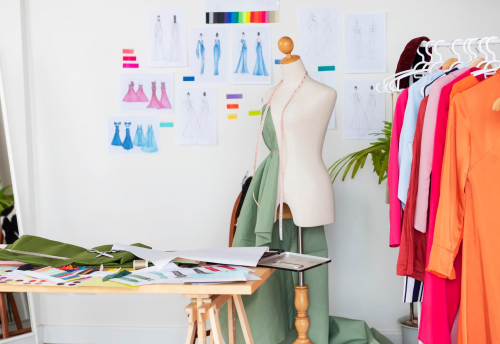
Build Your Future in Style: Career in Fashion Design
Education: Your Creative Foundation
The journey into a career in fashion design typically begins with education. Fashion designing courses serve as the bedrock of knowledge, teaching you the principles of garment construction, textile knowledge, and fashion business. Pursuing a fashion design degree equips you with the practical skills and theoretical understanding necessary to navigate the industry.
Fashion Designers Create More Than Just Clothing
As a fashion designer, your canvas extends beyond clothing. You will be involved in creating accessories and footwear and may even venture into costume design for films and theatre. The role is multifaceted and often requires a keen understanding of fashion history, cultural influences, and current global trends.
CAD: Computer-Aided Design
In today’s digital age, fashion designers work extensively with computer-aided design programs. CAD allows for precise and efficient creation of designs, enabling designers to visualize their concepts in 3D and quickly make adjustments. This technological proficiency is crucial for staying competitive in the industry.
Communication: The Key to Success
In the fashion world, collaboration is critical. Whether you’re working with a team to prepare for a fashion show or communicating with clients, strong communication skills are indispensable. They ensure that your vision is understood and executed to perfection.
The Life of a Fashion Designer
Embarking on a fashion design career is to step into a world where art meets commerce, creativity aligns with practicality, and vision becomes reality. The life of a fashion designer is as varied as the fabrics they work with, encompassing a spectrum of activities beyond the drawing board.
Full-Time Dedication and Beyond
For many fashion designers, their career is a full-time commitment that often spills over into their time. Fast-paced environments with strict deadlines are typical in the fashion industry, particularly during busy times like fashion weeks and Christmas releases. Designers frequently spend long days ensuring that every element of their work meets their exact standards. Since they are prepared to invest the time required to perfect their craft, dedicated designers stand out from the crowd.
The Creative Process
- The lifeblood of a fashion designer is their creative process. It begins with inspiration, which can strike from anything:
- A pattern observed in nature
- An architectural form
- A vintage piece of clothing
Even a fleeting emotion
This inspiration is then translated into sketches, a process where ideas begin to take shape. From here, designers select fabrics, create prototypes, and work meticulously on garment construction. It’s a process that requires precise vision and a steady hand, as even the smallest element can transform the overall design.
Collaboration and Teamwork
While the image of a lone designer might be romantic, fashion designers work in a collaborative environment. They regularly interact with textile designers, pattern makers, tailors, and other professionals contributing to the final product. Practical communication skills are essential, as designers must convey their vision clearly and work alongside others to troubleshoot any issues that arise during the garment’s creation.
The Business of Fashion
A fashion designer’s role doesn’t continue after the creation of clothing; they must also understand the business aspect of the industry. This includes marketing their designs, understanding consumer behaviour, and managing finances. For those who run their labels, entrepreneurship skills are just as critical as their design talents.
The Emotional Rollercoaster
The fashion industry can be as emotionally demanding as it is rewarding. Designers often form a deep connection with their creations, making criticism or lack of recognition a potential source of disappointment. However, the joy of seeing their designs come to life on the runway or worn by individuals is an unparalleled high that fuels their passion and drives them forward.
Lifelong Learning
Fashion is an ever-evolving field, and successful designers are those who evolve with it. They continuously update their knowledge of new materials, techniques, and trends since they are lifelong learners. To be on the cutting edge of the field, many designers also broaden their skill set to incorporate new technologies like 3D printing or environmentally friendly manufacturing methods.
Global Influence and Travel
A career in fashion design can have a global reach. Designers often visit fashion shows, source materials, and find inspiration. This exposure to different cultures and practices not only influences their design aesthetic but also allows them to establish a presence in the international fashion scene.
Personal Satisfaction and Impact
Personal fulfilment is ultimately what drives a fashion designer’s career. It is satisfying to see a concept come to life and know that it affects how individuals express themselves via clothing. Designers not only shape individual styles but also contribute to the cultural landscape by pushing boundaries and setting trends.
In a nutshell, the life of a fashion designer is multifaceted and demanding yet incredibly rewarding. It’s a career that’s not just about creating clothes but about crafting a narrative, making a statement, and leaving a mark on the world—one design at a time.
The Global Stage: Fashion Designers in India and Beyond
India’s rich textile history has given rise to several well-known fashion designers who have achieved international recognition. Aspiring designers can look forward to these trailblazers as inspiration and strive to exhibit their work on platforms that are both national and worldwide.
Attending Fashion Shows
To stay ahead of nuances and network with industry professionals, budding designers must attend fashion shows. These events are not just about the spectacle; they are a learning ground for understanding market dynamics and consumer preferences.
Career Opportunities
Fashion Merchandiser: The Business Savvy Creative
A career in fashion design can include more than just creating apparel. As a fashion merchandiser, you will blend creative skills with business acumen to market and sell fashion items effectively.
The Freelance Route
Many fashion designers choose the path of freelancing, allowing them to work with various brands and clients. This path offers flexibility and the opportunity to build a diverse portfolio.
Enriching Your Career with Continuous Learning
The fashion industry is dynamic, and to stay relevant, one must be a lifelong learner. This means continuously updating your skills, whether it’s through advanced fashion designing courses or by learning about sustainable practices in garment construction.
Also Read : Career in Fashion Designing: Your Path to Success
Conclusion
The demands and rewards of a profession in fashion design are equal. Technical know-how, business acumen, and inventiveness must all be combined.
A career in this glamourous field may be achieved with the correct education, like that provided by the International College of Fashion, and a dedication to lifelong learning. Embrace the journey, for every stitch, sketch, and strategy contributes to the tapestry of your fashion legacy.



